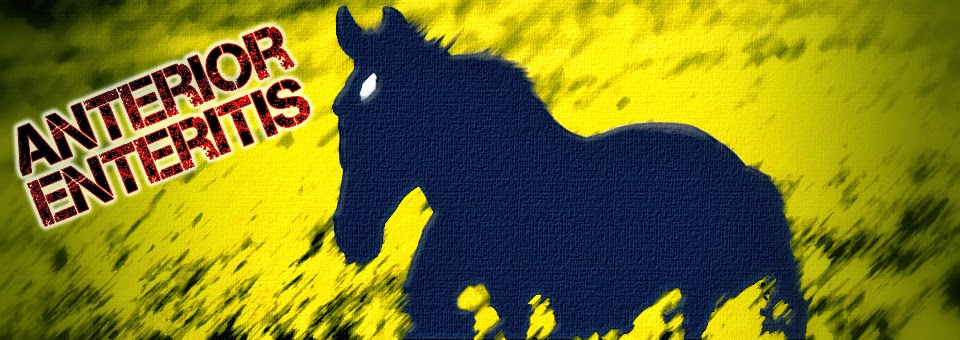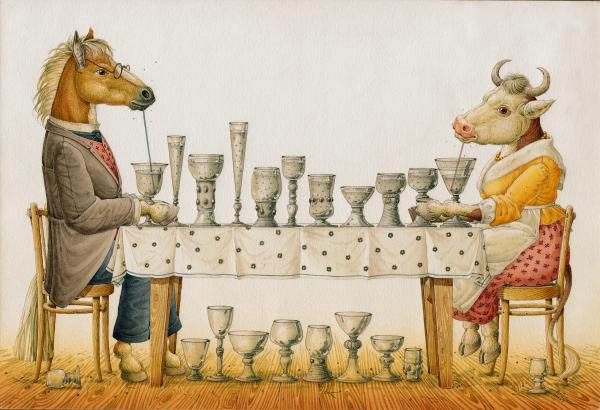You can get in touch with me by telephone or text during normal business hours, through the email form below, or by postal mail at the address listed below.
For emergencies, please call, do not use the contact form.
Contact
Contact Information
484-447-6945
P.O. Box 5011
Limerick, PA 19464
drjessvet.com
Anterior Enteritis
But I've Never Heard of That Kind of Colic!
Posted on: March 31, 2014

Anterior enteritis (AE)
Anterior enteritis also known as gastroduodenojejunitis or proximal duodenitis-jejunitis, is a confusing diagnosis for horse owners to understand. It is also difficult for veterinarians to explain, because we don't have all the answers as to why this condition occurs! Anterior enteritis is an inflammation of the small intestine (the small intestine is comprised of the duodenum, jejunum and ileum) which leads to colic signs in the horse. The small intestine in horses is approximately 60 feet long and functions to digest food material and absorb nutrients and fluids. Inflammation in the small intestine can cause absorption to slow dramatically and fluid to back up from the small intestine into the stomach, whose capacity is only two to three gallons. As the small intestine and stomach become increasingly more distended with fluid, the horse will show further signs of colic and pain. Since the horse is anatomically unable to vomit, this presents a potentially fatal problem, as the stomach could rupture if the disease is not diagnosed in time.
Pain from the pressurized intestines and stomach isn't the only problem with anterior enteritis. The inflammation and poor absorption caused by the disease can lead to toxins leaking into the bloodstream and causing a condition known as endotoxemia. Endotoxemia can cause serious damage such as laminitis (inflammation in the delicate and important structures holding the hoof together), colitis (inflammation of the colon further down the GI tract, possibly life-threatening diarrhea), and blood clotting issues. Prompt treatment of the underlying condition helps to ensure a more positive prognosis and fewer complications.
What do horses with anterior enteritis looks like? Similar to horses experiencing other types of colic (abdominal pain), affected horses may start off by appearing inappetant and depressed. As the pain increases, they may lie down, kick at their belly or even roll. The severity of colic signs depends on the degree of pain and also how sensitive that particular horse is to pain. On examination, we usually find an increase in heart and respiratory rates consistent with pain, sometimes discolored gums, and often a decrease in gut motility upon listening with a stethoscope. An increase in rectal temperature is also common, but not always present. When we perform a rectal examination, we can feel the gas- and fluid-distended loops of small intestine protruding back toward our hand, which are often described as feeling like multiple bicycle tire tubes filled with air. The next diagnostic step is very important for cases of anterior enteritis, as it is also part of the treatment. Placing a nasogastric tube from one nostril down into the stomach allows us to check the stomach for excess fluid, what we call "reflux". A normal horse should not have more than a liter or so of fluid in its stomach, but horses with AE may have up to three gallons!
Once we determine that there is an abnormal amount of fluid present (and after we remove it!), we have to find out if the cause is lack of motility due to anterior enteritis or due to a structural blockage such as a surgical-type colic (displacement, strangulated intestine, etc.). Surgical colics and AE may present very similarly in signs and severity of pain, but AE pain should be relieved by decompressing the stomach and administering pain medications, while surgical colics will continue to become more painful despite medical treatment. Taking a sample of the abdominal fluid surrounding the intestines and colon by performing a peritoneal tap with a needle may help with the diagnosis, as can ultrasound of the abdomen. Bloodwork is usually performed to monitor hydration and infection.
 Treatment of AE is aimed at reducing the inflammation in the intestine and stomach and helping to decrease the pressure until the body can start to function again properly on its own. Hospitalization is usually required, as round-the-clock decompression of the stomach with a nasogastric tube ("refluxing") has to be performed until excess fluid ceases to be produced, and fluid losses need to be replaced by IV fluids. I have been asked many times on the farm why a client's colicky horse isn't being "oiled" after I pass the nasogastric tube (and draw off several liters of reflux!), because most people have never experienced AE and don't initially understand. The horse may not eat or drink (or be given mineral oil!) during initial treatment as we are trying to reduce the load on the stomach and small intestine. As the reflux stops being produced, the horse will be weaned off IV fluids and back onto water and hay slowly. Medications such as Banamine are given for their anti-inflammatory and pain-relieving properties, and antibiotics may be given depending on the clinician's preference. Most horses "reflux" for up to 24 hours, and then slowly improve, generally going home after three to four days in the clinic. The prognosis is usually very good for survival of AE without complications, about 80%. Some horses may be affected by anterior enteritis again after being discharged, but it is impossible to determine this in advance.
Treatment of AE is aimed at reducing the inflammation in the intestine and stomach and helping to decrease the pressure until the body can start to function again properly on its own. Hospitalization is usually required, as round-the-clock decompression of the stomach with a nasogastric tube ("refluxing") has to be performed until excess fluid ceases to be produced, and fluid losses need to be replaced by IV fluids. I have been asked many times on the farm why a client's colicky horse isn't being "oiled" after I pass the nasogastric tube (and draw off several liters of reflux!), because most people have never experienced AE and don't initially understand. The horse may not eat or drink (or be given mineral oil!) during initial treatment as we are trying to reduce the load on the stomach and small intestine. As the reflux stops being produced, the horse will be weaned off IV fluids and back onto water and hay slowly. Medications such as Banamine are given for their anti-inflammatory and pain-relieving properties, and antibiotics may be given depending on the clinician's preference. Most horses "reflux" for up to 24 hours, and then slowly improve, generally going home after three to four days in the clinic. The prognosis is usually very good for survival of AE without complications, about 80%. Some horses may be affected by anterior enteritis again after being discharged, but it is impossible to determine this in advance.
So why does this happen? Unfortunately we are not completely sure. There is a possibility that AE is caused by an overgrowth of a Clostridial bacteria altering the digestion, but this cannot be proven in most cases. Sometimes the cause seems obvious, for example the horse ate too much grain, the diet was abruptly changed, or the horse ingested something it shouldn't (contaminated water or feed, grit from eating off the ground). It also could be started by a different kind of bacterial or viral infection, or internal parasites. Most times we have no idea why it has happened and just have to treat what we see. Like any colic, the ideal policy is to contact your veterinarian as soon as you notice any signs of pain, so you can decide the best plan of action and course of treatment together.